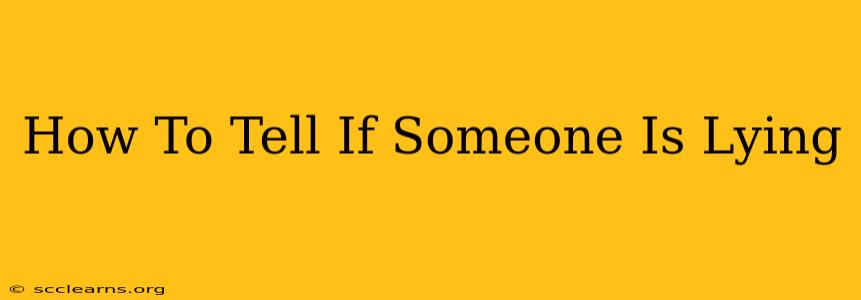Lying is a common human behavior, but detecting deception can be challenging. While there's no foolproof method, understanding common verbal and nonverbal cues can significantly improve your ability to identify when someone might not be telling the truth. This guide provides practical strategies and insights to help you discern truth from falsehood.
Understanding the Challenges of Lie Detection
Before diving into specific techniques, it's crucial to acknowledge the complexities involved. People lie for various reasons, and their deceptive behaviors can vary greatly depending on personality, the stakes involved, and their experience with deception. Furthermore, misinterpreting nonverbal cues can lead to inaccurate conclusions. Accurate lie detection requires careful observation and critical thinking.
The Limitations of Body Language Analysis
While observing body language can offer clues, relying solely on nonverbal cues is unreliable. Many factors besides deception can influence body language, such as nervousness, shyness, or cultural differences. Don't jump to conclusions based on a single gesture or expression.
Key Verbal and Nonverbal Indicators of Deception
This section outlines some common indicators, but remember that these are not definitive proof of lying. Consider them as potential red flags requiring further investigation.
Verbal Cues: What to Listen For
- Inconsistencies: Pay close attention to inconsistencies in the narrative. Do their statements contradict previous claims or known facts?
- Evasive Answers: Do they avoid direct answers, use vague language, or change the subject frequently?
- Overly Rehearsed Responses: A rehearsed answer might sound too perfect or lack the natural flow of genuine conversation.
- Exaggerated Detail: While detail can be a sign of truthfulness, excessive detail, especially regarding unimportant aspects, can be a way to distract from the core issue.
- Hesitations and Stuttering: While nervousness can cause these, they can also indicate difficulty in fabricating a lie.
Nonverbal Cues: What to Observe
- Microexpressions: These are fleeting facial expressions that can reveal underlying emotions. They are difficult to control and can provide valuable insights.
- Eye Contact: While prolonged eye contact can be a sign of confidence, avoidance of eye contact can indicate deception – but cultural norms should be considered.
- Body Language: Fidgeting, shifting weight, covering the mouth, or crossing arms can signal discomfort or deception, but these are not universally reliable indicators.
- Changes in Tone of Voice: A change in pitch, volume, or speech rate can also signal stress or deception.
Strategies for Effective Lie Detection
- Establish a Baseline: Before questioning the person, observe their normal behavior to establish a baseline for comparison.
- Ask Open-Ended Questions: Encourage detailed responses to uncover inconsistencies. Avoid leading questions.
- Pay Attention to the Details: Focus on the specifics of their story. Small inconsistencies can be more revealing than major ones.
- Use Controlled Re-Questioning: Rephrase questions in different ways to see if their answers remain consistent.
- Consider the Context: Always consider the context of the situation and the individual's personality.
When to Seek Professional Help
In situations involving serious accusations or legal matters, seeking professional assistance from a trained investigator or lie detection expert is crucial. They possess advanced skills and tools to assess the validity of information.
Conclusion: The Importance of Critical Thinking
Detecting lies is a complex skill that improves with practice and experience. Remember, no single indicator definitively proves deception. Effective lie detection requires a holistic approach, combining careful observation, critical thinking, and awareness of the limitations of the methods employed. Always prioritize thoughtful consideration and avoid making hasty judgments based solely on perceived nonverbal cues.

